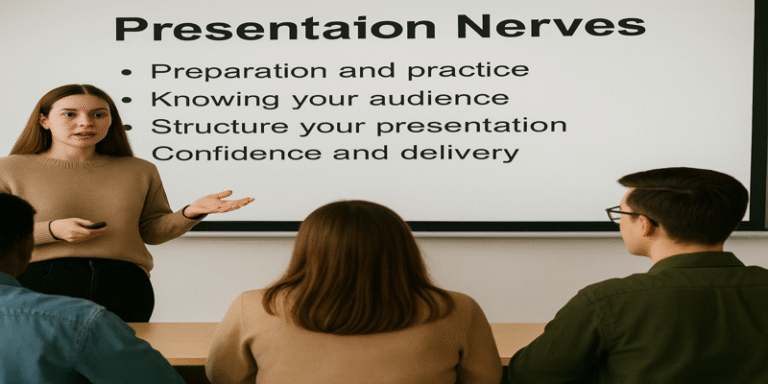Presenting in front of others remains one of the most common sources of anxiety for students and professionals alike. Often labelled glossophobia, the fear of speaking before an audience can manifest in physical symptoms such as sweating, trembling, or a racing heart, alongside psychological effects including self-doubt and negative thinking (Bodie, 2010). While nerves are natural, unmanaged anxiety can hinder communication, reduce clarity, and undermine confidence. This article explores practical strategies for managing presentation nerves like awkward interruptions, difficult questions, and stage fright, drawing upon insights from textbooks, scholarly research, and professional practices to develop a comprehensive understanding of how to manage presentation nerves effectively.
Understanding Presentation Anxiety
Presentation anxiety has both psychological and physiological roots. According to Raja (2017), students often perceive public speaking as a threatening situation due to fear of judgement, evaluation, or failure. The cognitive-behavioural model suggests that anxious speakers engage in negative self-talk (“I will make a mistake”), which heightens physiological arousal, thereby worsening performance (Bodie, 2010).
Kho and Ting (2023) note that tertiary-level students across ESL and EFL contexts particularly struggle with presentation anxiety, as they must simultaneously manage language barriers and communication apprehension. Similarly, Rabbiani (2024) shows that group practice reduces nervousness, as shared experiences provide reassurance and lessen feelings of isolation.
In short, presentation nerves are not simply a matter of personality weakness but a predictable reaction to perceived social evaluation. Recognising this is the first step in normalising anxiety and developing effective coping strategies (Shapiro, 2024).
Coping with Awkward Interruptions and Questions
Managing interruptions requires both tact and authority. Jurin, Roush and Danter (2010) argue that speakers must maintain control of the floor while demonstrating respect for the audience. A polite response such as: “That is a valuable point; perhaps we can return to it at the end” allows presenters to remain in charge without dismissing audience contributions.
When faced with awkward or difficult questions, transparency is critical. Admitting uncertainty does not diminish credibility; instead, it signals intellectual honesty. Ireland (2020) found that students who openly acknowledged gaps in knowledge were perceived as more authentic by peers. For example, in academic or professional conferences, presenters often respond with: “That is an interesting angle; I will explore it further.” This approach reframes vulnerability as strength, building trust with the audience.
Managing Mistakes and Stage Fright
Mistakes during presentations are inevitable. The most effective response is to pause, take a breath, and correct oneself calmly. This technique mirrors diaphragmatic breathing, which reduces physiological arousal and restores composure (Lamarca, 2023).
Stage fright, described as a surge of fight-or-flight response, is almost universal. Northedge (1990) argues that practice and exposure are the most effective remedies. Carlisle et al. (2025) demonstrate that repeated exposure to virtual reality (VR) simulations of public speaking significantly reduces anxiety among university students. Similarly, Pertaub, Slater and Barker (2002) found that rehearsing in front of virtual audiences enables gradual acclimatisation without real-world risks.
In higher education, accountancy students frequently report anxiety around oral assessments. Ireland (2020) revealed that after structured rehearsal, students’ confidence grew significantly, with anxiety levels reduced over time.
Psychological Reframing and Positive Mindsets
Reframing presentations as opportunities rather than threats can transform anxiety into motivation. Inyai (2024) highlights that adopting a growth mindset enables learners to perceive mistakes as learning opportunities instead of failures.
Other methods such as humour and storytelling also alleviate nerves. Viet Vu (2024) shows that speakers who incorporated non-verbal cues and humour reported lower anxiety levels, since these techniques fostered audience connection and reduced formality.
Post-Presentation Reflection
Reflecting after a presentation is crucial for long-term improvement. According to Kolb’s (1984) experiential learning cycle, reviewing performance allows learners to adapt and refine their skills.
Hafiz (2015) found that self-reflection journals enable students to identify triggers of nervousness and track progress. Similarly, Apriani, Puspitasari and Fathudin (2025) observed that systematic feedback loops fostered continuous development in public speaking among EFL learners.
Practical Strategies for Overcoming Nerves
Drawing from academic literature and professional practices, the following strategies are consistently effective:
- Preparation and rehearsal – Being well-prepared reduces uncertainty (Marshall & Rowland, 1998).
- Breathing exercises – Practising diaphragmatic breathing calms the nervous system (Lamarca, 2023).
- Gradual exposure – Start with small groups, then scale to larger audiences (Carlisle et al., 2025).
- Reframing thoughts – Replace negative self-talk with affirmations (“I am sharing valuable insights”) (Raja, 2017).
- Audience engagement – Asking rhetorical questions or using humour creates rapport (Viet Vu, 2024).
- Use of technology – VR platforms provide safe spaces to rehearse (Pertaub et al., 2002).
- Peer support – Group presentations distribute responsibility and provide reassurance (Rabbiani, 2024).
Presentation nerves are a natural part of public speaking, but they need not be debilitating. With the right strategies—preparation, reframing, breathing, and reflection—individuals can transform anxiety into confidence. Audiences are rarely there to criticise; rather, they want to listen, learn, and engage. By integrating insights from textbooks, journal studies, and modern technologies such as VR, it becomes clear that managing public speaking anxiety is less about eliminating nerves altogether and more about harnessing them constructively. With practice and reflection, confidence grows, and what was once a source of fear becomes an invaluable opportunity for personal and professional growth.
References
Apriani, N., Puspitasari, D. & Fathudin, A.U. (2025). Overcoming challenges in public speaking: A journey of self-improvement. International Journal of Education, Language and Teaching. Available at: https://ijelt.com/index.php/ijelt/article/view/29.
Bodie, G.D. (2010). A racing heart, rattling knees, and ruminative thoughts: Defining, explaining, and treating public speaking anxiety. Communication Education, 59(1), pp.70-105. https://doi.org/10.1080/03634520903443849.
Carlisle, D.D.E., Gillies, M., Park, S. & Cheng, Z. (2025). Reducing foreign language anxiety through repeated exposure to a customizable VR public speaking application. Frontiers in Virtual Reality. https://doi.org/10.3389/frvir.2025.1519409.
Hafiz, R. (2015). Strategies for overcoming fear to become an elegant presenter. Strategies. CORE. Available at: https://core.ac.uk/download/pdf/234626712.pdf.
Ireland, C. (2020). Apprehension felt towards delivering oral presentations: A case study of accountancy students. Accounting Education, 29(5), pp.475-494. https://doi.org/10.1080/09639284.2020.1737548.
Inyai, C. (2024). Support guidelines to promote growth mindsets in public speaking for upper secondary EFL students. Chulalongkorn University. Available at: https://digital.car.chula.ac.th/chulaetd/12546/.
Jurin, R.R., Roush, D. & Danter, J. (2010). Speaking to an Audience. In: Environmental Communication. 2nd ed. Springer, pp. 253–273.
Kho, M.G.W. & Ting, S.H. (2023). Overcoming oral presentation anxiety: A systematic review of tertiary ESL/EFL students’ challenges and strategies. ResearchGate. Available at: https://www.researchgate.net/publication/375237903.
Kolb, D.A. (1984). Experiential Learning: Experience as the Source of Learning and Development. Englewood Cliffs: Prentice Hall.
Lamarca, C.A.J. (2023). The use of diaphragmatic breathing in alleviating Thai students’ public speaking anxiety. HCU Journal. Available at: https://has.hcu.ac.th/xmlui/handle/123456789/3226.
Marshall, L. & Rowland, F. (1998). A Guide to Learning Independently. 3rd ed. Milton Keynes: Open University Press.
Northedge, A. (1990). The Good Study Guide. Milton Keynes: Open University Press.
Pertaub, D.P., Slater, M. & Barker, C. (2002). An experiment on public speaking anxiety in response to three different types of virtual audience. Presence, 11(1), pp.68–78. https://doi.org/10.1162/105474602317343668.
Rabbiani, F.S. (2024). The students’ public speaking anxiety in academic presentation: A case study. Journal of English Education and Literature. Available at: http://jose.sinarlima.com/index.php/JOEEAL/article/view/75.
Raja, F. (2017). Anxiety level in students of public speaking: Causes and remedies. Journal of Education and Educational Development, 4(1), pp.94–110. Available at: https://files.eric.ed.gov/fulltext/EJ1161521.pdf.
Shapiro, D. (2024). Oral presentations: Normalising presentation anxiety and inclusive public speaking pedagogy. In: Transforming Traditional Teaching. Routledge.
Viet Vu, A. (2024). Overcoming public speaking anxiety through nonverbal communication, preparation, humour, and interviewing techniques. Anna Maria College. Available at: https://annamaria.edu/wp-content/uploads/2025/08/Viet-Vu-Fall-2024.pdf.









